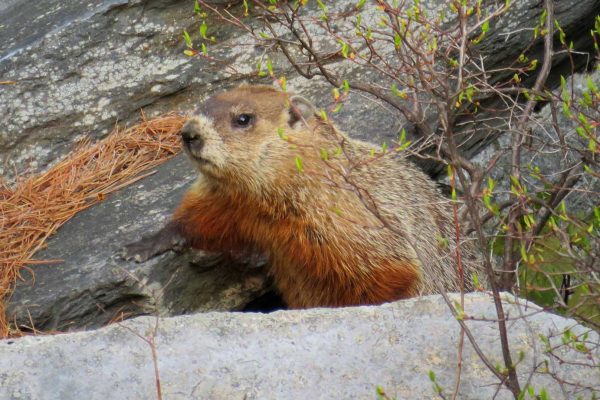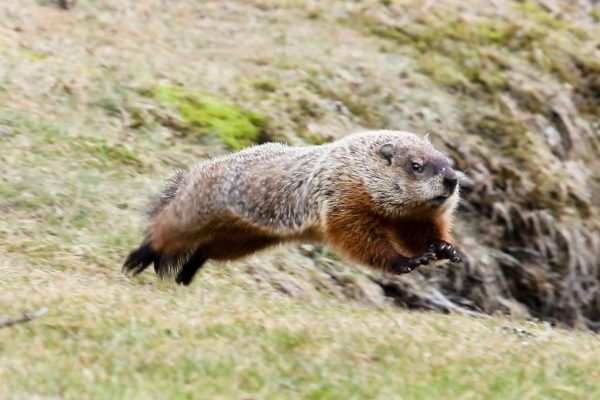
Woodchuck at Sebec Lake, by Jayne Winters
Woodchuck
Marmota monax
Cool Fact: Woodchucks are also called whistle pigs (because of the alert whistle they make when alarmed), earth pigs, land beavers, and grass rats!
Most of us are familiar with the legend of the groundhog seeing its shadow (or not) to determine whether there will be six more weeks of winter or if spring is on the way. But do you know its origin? When German immigrants settled in Pennsylvania in the 1700s, they brought with them the tradition of Candlemas Day, a holiday recognized between Winter Solstice and Spring Equinox (if the weather was fair on Candlemas Day, the second half of winter would be stormy and cold). In Germany, they watched a badger check for its shadow to determine the “forecast,” but because there were no badgers in Pennsylvania, they decided the next best thing was the woodchuck.
Yes, woodchuck and groundhog are names for the same critter. It’s the largest member of the squirrel family, specifically ground squirrels, known as marmots. The name woodchuck has nothing to do with wood or chucking: it appears to have come from its Native American (Algonquian) name, wuchak.
As humans cleared forests for logging, homes, and roads, woodchucks left their original woods habitat to take advantage of the abundant foods found in fields, meadows, and grassy clearings. They eat about a third of their weight daily, consuming mostly plants, flowers, nuts, fruits, and sometimes insects and grubs. An adult can eat more than a pound of vegetation daily. Thought not to drink water, groundhogs are reported to get necessary liquids from the juices of plants, fruits, etc., along with rain or dew.

Groundhog in Bangor, by David Small
They’re excellent diggers and make their homes in complex, multi-level burrow systems, which can be from 2-20’ deep and up to 700’ long with multiple chambers; it’s not unusual for them to dig a 5-foot tunnel in a day. Woodchucks can move almost three tons of dirt excavating a burrow. Burrows are dug in slopes of at least 30 degrees, with good drainage, close to food and water, with up to a dozen entrances. Although groundhogs are the most solitary of the marmots, several individuals may occupy the same burrow.
Woodchucks are 20-27” long, weigh 5-15 pounds, and have reddish-brown fur mixed with gray guard hairs; generally, they have darker faces, tails, legs, and feet. They have short, muscular legs designed for digging and large front teeth; they are accomplished swimmers and occasionally climb trees. Their lifespan in the wild is typically three to six years, but in captivity is often triple that!
Woodchucks are true hibernators. In July, their metabolism slows, and even as their food intake decreases, their weight may increase by as much as 100% due to the fat deposits (up to ½” thick). By mid-October, they’ve gone into their winter burrow. The heart rate during hibernation slows from 80 beats per minute to 5 beats per minute; breathing slows from 16 breaths per minute to just two; and body temperature drops from 97 to 40 degrees F. They start coming out of this state between January and March.
Mating doesn’t occur until their second year, in March or April, after they emerge from their burrows. Following a 32-day gestation period, a single litter of 2 to 9 kits are born in late spring. Adult males may remain with their mate, but usually have no role in rearing the young. The female nurses the kits, as well as brings them greens. They open their eyes at four weeks, are weaned at six weeks, and evicted from the burrow in July or August, to establish their own territories.
Much to the dismay of gardeners, woodchucks love vegetables, especially broccoli, peas, beans, carrot tops, lettuce, and squash. Fencing can help deter them, but because they can burrow under and climb over it, you may want to plant gopher plants or crown imperial fritillary around the garden to repel them or treat the area repeatedly with various repellents, such as fox or coyote urine, diluted Tabasco sauce, red pepper flakes, or scattered human hair. Despite raiding gardens, woodchucks play an important role in maintaining healthy soil in woodlands and grassy areas.
—by Jayne Winters
Resources:
https://www.massaudubon.org/nature-wildlife/
https://sheldrakecenter.org/top-10-fun-facts-about-groundhogs/
https://en.wikipedia.org/wiki/Groundhog
https://www.maine.gov/ifw/fish-wildlife/wildlife/species-information/mammals/woodchuck.html









